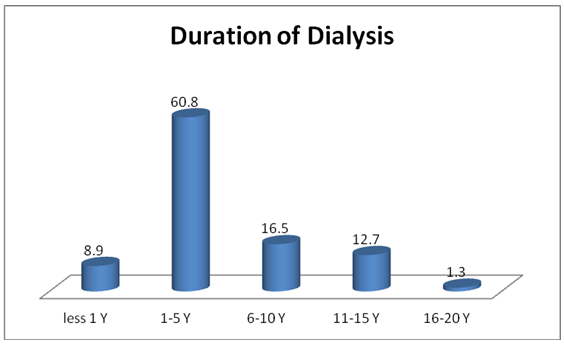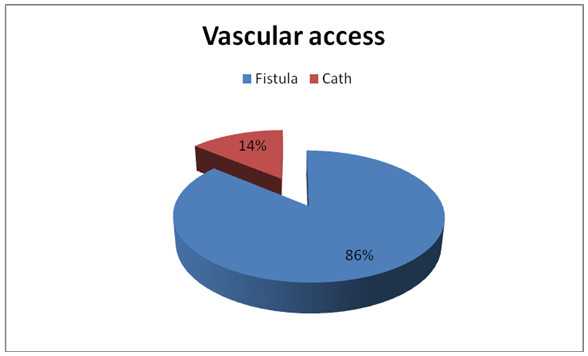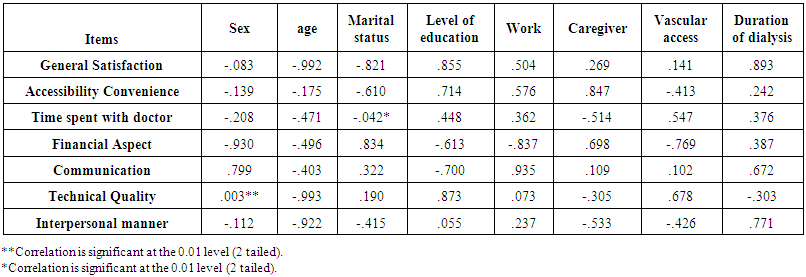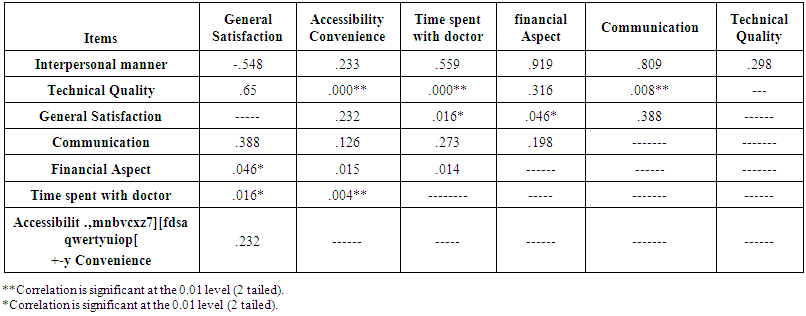-
Paper Information
- Paper Submission
-
Journal Information
- About This Journal
- Editorial Board
- Current Issue
- Archive
- Author Guidelines
- Contact Us
International Journal of Nursing Science
p-ISSN: 2167-7441 e-ISSN: 2167-745X
2016; 6(5): 117-122
doi:10.5923/j.nursing.20160605.02

Patients’ Satisfaction with Care at Dialysis Unit
Magda Bayoumi1, Hoda A. El Guindy2, Abeer Ahmed3
1Lecturer at Medical Surgical Nursing Department, Nursing Faculty, Beni-Suef University, Egypt
2Lecturer at Nursing Administration Department, Nursing Faculty, Beni-Suef University, Egypt
3Lecturer at Nursing Department, Al Farabi Colleges, Riyadh, Saudi Arabia
Correspondence to: Magda Bayoumi, Lecturer at Medical Surgical Nursing Department, Nursing Faculty, Beni-Suef University, Egypt.
| Email: |  |
Copyright © 2016 Scientific & Academic Publishing. All Rights Reserved.
This work is licensed under the Creative Commons Attribution International License (CC BY).
http://creativecommons.org/licenses/by/4.0/

Patients’ satisfaction assessment is becoming an important indicator of health care outcomes and considers as evidence for better patient satisfaction, it might be associated with better medical outcomes. The aim of this study is to assess the patients’ satisfaction with care in the dialysis unit. Methods: The cross-sectional study was used and the study sample was selected from Beni-Suef University Hospital. (November to December 2015), the total number 79 patients were completed the patient satisfaction PS18 Questionnaire. Results: This study involved 79 patients on hemodialysis. The sample has slightly more males (59.5%) and the majority of the patients are married (74.7%), and their education was mostly read and write (48.1%) or primary (26.6%). Whereas more than half of the patients on dialysis therapy between 1 and 5 years and Significant variation in all dimensions reported by patients were unsatisfied except time spent with doctor (64.6) and accessibility & convenience (57.0). Moreover technical quality was good (53.2%). Furthermore, the correlation between patients’ satisfaction dimensions and patients personal characteristics’ there were highly significant correlation (P=.003) between sex and technical quality, while marital status was negatively correlated (P=-.042) with time spent with doctor. Nonetheless, our results suggest that almost half of the study sample reported in general Satisfaction were unsatisfied, however the financial aspect, communication and interpersonal manner should be achieved to improve health care outcome then subsequently increase level of patients’ satisfaction, and further research regarding patient satisfaction is required.
Keywords: Hemodialysis, Patient satisfaction, Egypt
Cite this paper: Magda Bayoumi, Hoda A. El Guindy, Abeer Ahmed, Patients’ Satisfaction with Care at Dialysis Unit, International Journal of Nursing Science, Vol. 6 No. 5, 2016, pp. 117-122. doi: 10.5923/j.nursing.20160605.02.
Article Outline
1. Introduction
- Numerous scientific and technical advances in hemodialysis therapy and the outcomes of patients with end stage renal disease are far from reaching the desired targets [1]. However better outcomes absolutely are associated with patient involvement in the health care process [2, 3]. Nowadays, Patient with end stage renal disease (ESRD) treated by hemodialysis therapy (HD) suffers less from hypotension, nausea, vomiting, cramps, headache and dizziness, In addition; related to reliable monitoring devices, better water quality, physiological bicarbonate-based dialysate and machines to control ultrafiltration. However, all of those factors can improve the patient well-being and patient satisfaction during treatment sessions [4]. The prevalence of end stage renal disease (ESRD) is increasing worldwide; In Egypt, the estimated annual incidence of ESRD is around 74 per million, and the total prevalence of patients on dialysis is 264 pmp [5].Whereas patient satisfaction is very important aspect to evaluate health care outcome, so patient satisfaction has been often defined as the extent of agreement between what a patient expects to result or obtain from the healthcare experience and the perception of care they actually receive [6].This definition implies that the individual has formed expectations prior to or during the healthcare experience, and that at some point, must consider whether of the services received during the experience meet, do not meet, or exceed those expectations. The first attempts to evaluate patient satisfaction with healthcare services originated within nursing in 1956 [7].Most recent studies focusing on quality of health care services provided specially for chronic patients, for recognizing the importance of patient satisfaction in assessing quality of medical care. Significance of the study:Patient satisfaction is considering as an important indicator for evaluating the health care outcomes, while affects clinical performance, patient retention and medical malpractice [8]. Furthermore it may be a very effective indicator to measure the success of health care team especially in dialysis unit when deal with chronic patient undergoing hemodialysis therapy.Aim: to assess the patients’ satisfaction with care in the dialysis unit.Research Question: Are the patients satisfied with Care at dialysis unit?
2. Methods
- Setting: The study will be conducted at the hemodialysis unit in Beni Suef University Hospital. It consists of four rooms; two for patients who have hepatitis B & C negative, the 3rd room for patients who have hepatitis C positive and the 4th room for acute cases. The average weekly admission number of patients receiving maintenance/ regular hemodialysis is 79 patients.Sampling: Patients were recruited from dialysis unit, at Beni-Suef University Hospital from November to December 2015. All questionnaires were distributed by one investigator, and interview completed with patient in 15 minutes during their dialysis session.Design: cross-section study design was used. Inclusion criteria; age: <18 and >85 years, both sex, on maintenance hemodialysis therapy for at least three-months and willing to participate in the study.Exclusion criteria: The only exclusion criterion was the presence of any diagnosed of mental retardation or dementia.
3. Data Collection
- Study instrumentsDemographic data and Dialysis characteristics of patients in the study sample (n=79): age, sex, work status, level of education, Marital status, duration of dialysis, and the main caregiver characteristics, vascular access.The PSQ-18 is a short form version [9] the PSQ-18 yields separate scores for each of seven different subscales: General Satisfaction (Items 3 and 17); Technical Quality (Items 2, 4, 6, and 14); Interpersonal Manner (Items 10 and 11); Communication (Items 1 and 13); Financial Aspects (Items 5 and 7); Time Spent with Doctor (Items 12 and 15); Accessibility and Convenience (Items 8, 9, 16, and 18). Some PSQ-18 items are worded so that agreement reflects satisfaction with medical care, whereas other items are worded so that agreement reflects dissatisfaction with medical care. All items should be scored so that high scores reflect satisfaction with medical care.
 Validity and ReliabilityThe translated instrument is used in the present study were examined for validity by 6 experts in two specialties, nursing administration and medical surgical nursing. A Cronbach' s alpha coefficient was calculated to assess the published instrument for internal consistency.Pilot studyThe pilot study conducted on 10% of the total study sample to ensure the clarity and applicability of the tool and the time needed to complete them, no modifications were done. Patients participated in the pilot study were included in the total sample size, because of small sample size.Operational DesignPreparatory phaseDuring this phase, the research tool was translated to Arabic and reviewed by experts for finalization. It has also involved preparation of the settings for the study at dialysis unit in Beni Suef University Hospital.Field workPersonal interviews with the patients were scheduled at study settings. The researcher started to collect data daily from patients along the three shifts of work. A number of 3-5 patients were interviewed per day. The interview took from 10-15 minutes. The process of data collection took a period of two month, November to December 2015.Administrative DesignAn official permission was obtained from the administrator of the hospital after explaining the nature of the work. The researcher met with them and explained the aim and the process of the study. Patients’ consents were obtained. Complete confidentiality of any obtained information was ensured. The researcher has also assured the administration that the conduction of the study will not affect the work in the study settings. The results of the study will be provided to the hospitals’ authorities.Statistical DesignData entry and statistical analysis were done using SPSS 16.0 statistical software package.
Validity and ReliabilityThe translated instrument is used in the present study were examined for validity by 6 experts in two specialties, nursing administration and medical surgical nursing. A Cronbach' s alpha coefficient was calculated to assess the published instrument for internal consistency.Pilot studyThe pilot study conducted on 10% of the total study sample to ensure the clarity and applicability of the tool and the time needed to complete them, no modifications were done. Patients participated in the pilot study were included in the total sample size, because of small sample size.Operational DesignPreparatory phaseDuring this phase, the research tool was translated to Arabic and reviewed by experts for finalization. It has also involved preparation of the settings for the study at dialysis unit in Beni Suef University Hospital.Field workPersonal interviews with the patients were scheduled at study settings. The researcher started to collect data daily from patients along the three shifts of work. A number of 3-5 patients were interviewed per day. The interview took from 10-15 minutes. The process of data collection took a period of two month, November to December 2015.Administrative DesignAn official permission was obtained from the administrator of the hospital after explaining the nature of the work. The researcher met with them and explained the aim and the process of the study. Patients’ consents were obtained. Complete confidentiality of any obtained information was ensured. The researcher has also assured the administration that the conduction of the study will not affect the work in the study settings. The results of the study will be provided to the hospitals’ authorities.Statistical DesignData entry and statistical analysis were done using SPSS 16.0 statistical software package.4. Results
- This study involved 79 patients on hemodialysis. The sample has slightly more males (59.5%), shown in Table 1. The majority of the patients are married (74.7%), and their education was mostly read/write (48.1%) or primary (26.6%). Regarding to figure 1, more than half of the patients on dialysis therapy between 1 and 5 years. According to figure 2, the majority of the patients have a fistula connection (86%). Table 2 demonstrates the scores of patients’ satisfaction components scores. Significant variation in all dimensions reported patient unsatisfied except Time spent with doctor (64.6) and Accessibility & Convenience (57.0). Moreover about 53.2% reported the technical quality was good. Table 3 illustrates the correlation between patient satisfaction dimensions and patients personal characteristics’. There were highly significant correlation (P=.003) between sex and technical quality, while marital status was negatively correlated (P=-.042) with time spent with doctor. However; result is noticed that the statistically positive correlations were between technical Quality and this following subscales; Accessibility & convenience (.000), time spent with doctor (.000) and communication (.008). Moreover, table 4 illustrates the general satisfaction was statistically significant positive correlation with financial aspect (.046) and time spent with doctor (.004), as well as the accessibility & convenience was positive correlation with time spent with doctor (.004).
|
 | Figure 1. Dialysis duration of patients in the study sample (n=79) |
 | Figure 2. |
|
 | Table 3. Relation between satisfaction dimensions and patients’ personal characteristics |
 | Table 4. Correlations among various satisfaction dimensions scores |
5. Discussion
- There are many methods of improvement level of clinical care provided can be achieved to ameliorate patient satisfaction [10]. Because dialysis therapy is a very complex and challenging area of patient with end stage renal disease [11-13]. However assessment of patients’ satisfaction is very important to evaluate the health care outcomes. Regarding to the prevalence of hospitalized with chronic renal failure in Egypt is approximately 1.36% of all hospitalized Egyptian patients. The incidence population in developed countries is 6-8 per 100.00/year [14, 15].The foregoing present study finding concerning the level of general satisfaction was statistically significant positive correlation with financial aspect and time spent with doctor, as well as the accessibility & convenience was positive correlation with time spent with doctor. This finding is in the agreement with research at Saudi Arabia which was reported the mean overall dialysis satisfaction score for all the 3 dialysis centres was 7.41 ± 2.75. It was noted to be highest in Riyadh patients (9.0 (2.0)) followed by Dammam patients (6.5 (2.4)) and Buraidah (4.7 (2.2)) (P < .0001) [14]. It is worth noting that the results obtained in Riyadh patients in terms of “overall dialysis satisfaction” and “effect of the dialysis therapy on their life generally” were similar to those reported in USA patients [16].Our results in agreement with study by Al Eissa et al; 2010 reported when analyzing the impact of duration since the commencement of dialysis on the 15 QOL domains. They found that duration of more than 3 years was associated with more stress and worse financial burden which is perhaps not surprising given the impact of long-standing dialysis on employability this result matching with other study done by Al-Jahdali et al 2010 [17]. In contradiction with the finding regarding to socio-demographic data, the previous study Studied all domains of patients’ Quality of life undergoing hemodialysis therapy and found that all domains viewed positively (score>80) were “patient satisfaction,” “dialysis staff encouragement,” and “quality of social interaction.” These scores were not affected by level of education, age, duration on dialysis, or cause of renal failure [18].Other study in the same line of the current study findings studied the Staff burnout and patient satisfaction with the quality of dialysis care and data collected from 10 dialysis centers across northern Italy, the analysis of patient overall satisfaction assessments showed general appreciation for the "courtesy" and "kindness" of staff, but evidence of problems regarding organizational aspects and structural factors. However, the most critical dimension was for "information." There was a significant positive correlation between staff personal accomplishment and client satisfaction (P < 0.01) and a significant negative correlation between staff emotional exhaustion and patient satisfaction (P < 0.01). No significant correlation was found between staff depersonalization and patient satisfaction level [19]. The current finding described the scores of patients’ satisfaction components and patient reported unsatisfied except Time spent with doctor and accessibility & convenience, moreover about 53.2% reported the technical quality was good. In the agreement with study done in south African, patients’ satisfaction correlated with quality of care or renal nurse depended upon personal quality of nurse and time spend with the nurse and doctor [20].Recent research studied the effect of hemodiafiltration on quality of life over time and found the quality of life domain patient satisfaction declined over time in both dialysis modalities [19], so in our study no significant correlation between duration of dialysis and all domains of patients’ satisfaction. More relevant to the present study reported by Ferrans et al aimed to assess the satisfaction with care of hemodialysis patients, and to explore the relationships between satisfaction with care, quality of life, and background variables, and found overall patients were satisfied with their care (M = 5.04, range = 1 to 6), furthermore an ANOVA demonstrated that patients were most satisfied with physician related aspects of care, followed by nursing/dialysis treatment aspects, and least satisfied with financial/transportation aspects (F(2,830) =28.44. p less than .0001), moreover the patients who had been on dialysis for a shorter length of time or who had less education were more satisfied with care [21].
6. Conclusions
- The study concluded that almost half of the study sample reported in general satisfaction were unsatisfied. Significant variation in all dimensions reported patient unsatisfied except time spent with doctor and accessibility & convenience. Moreover More than half reported that technical quality was good.
7. Recommendations
- 1. Communication and interpersonal manner should be achieved to improve health care outcome.2. Assessment of patient satisfaction is very important indicator to reflect quality of health care services and speciality nursing care; institutions are not routinely assess for patient satisfaction. To date, very little research has occurred in the health care setting. For these reasons, additional prospective research is needed to further understand and improve patient satisfaction.
 Abstract
Abstract Reference
Reference Full-Text PDF
Full-Text PDF Full-text HTML
Full-text HTML
